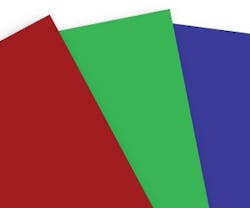Versus: RGB
In a world where designers are inundated with choices, you'd think color would be the one place where you could count on ease of application. That's not the case, unfortunately.
"Color is never so simple as a hue, a texture, or effect," said Mark Woodman, immediate past president of the Color Marketing Group. "Branding, gender, age, and price all play a role," as well as the sheen level and materials used.
Unfortunately, we can't demystify color completely, but Woodman has graciously offered up some tips on the best practices for a few of the basics (red, green, and blue) when applying them to major market segments. Find out where he says they work best, in what hues, and what to avoid.
| RED | GREEN | BLUE | |
| Corporate | Works best in public spaces where people need to move quickly. Use red in small doses, such as in artwork, accessories, or illuminated glass. | A good choice for many areas of the office, from lobbies and reception to offices and rest rooms. Stained woods, floors, and fiber rugs (dyed dark green) are a natural look underfoot. | Good for almost all spaces, as blue is trustworthy, classic, and natural. |
| Education | Can be very good as a wayfinder, especially in elementary flooring. In food halls, it can have the same effect as in hospitality. | Works well in brighter hues for wayfinding. | Its relaxing quality can be a detriment, so hues have to be kept clean (no toning with grey). Make sure to keep it natural and fresh, instead of too calming (or depressive, in the case of gray-blues). |
| Healthcare | Must be used carefully because of its connection to blood. Use red in small touches as an energy boost in common areas. Can be lightened to coral or pink, which reflects well on people, offering a healthy glow. | Good for upholstery, accent floorings, walls, and accessories. Unless too dark, green is generally upbeat and speaks to healthy living. It can also help people in long-term care feel more connected to nature. | Good for common areas, reception, and waiting lounges; great if influenced with green (though not teal). Aqua, turquoise, and petrol represent crossover blue-greens that satisfy the desire for blue without the low charisma of gray-blues. |
| Hospitality | Works well in dining spaces as an appetite stimulant. Bright versions move people along in grab 'n' go areas, while deeper versions are better for more formal dining areas. | Calms red and brings nature indoors, but its values have to be lighter. Dark greens are considered out of fashion. Light- to mid-value greens are the order of the moment. | Difficult in restaurants but can be used as accents with water glasses, flatware, seating—items where the color happens peripherally. Blue is risky for flooring, but can be a good background for a pattern. |
| Retail | Good for juvenile clothing areas. Deeper, matte hues of red are also good for menswear, but not the best for womenswear. | Ideal for freshening and energizing cosmetic and fragrance areas. Green can also be used as an accent with plants, upholstery, and some walls. | Almost any version can be used, though very light or very dark blend the best with other hues. Almost any value of blue can be used in menswear. If using a dark hue in womenswear, pair it with crisp white or another brighter color. |
